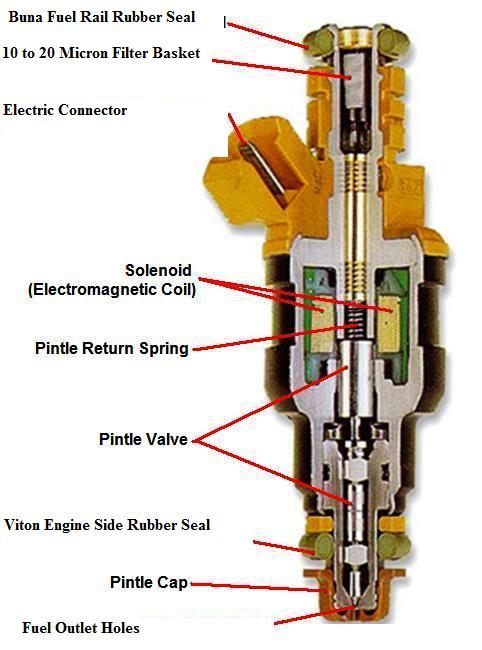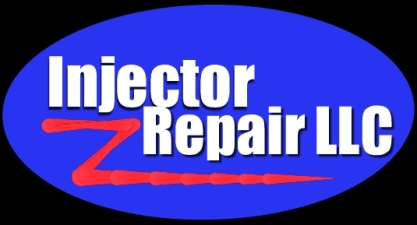Fuel Injection Knowledge Base

Photo: Bosch
Fuel Injector Components
“ The injector has a manufacturing tolerance of 1 micron, the finest tolerances of any mechanical component on the engine. ” Bosch.

How does a fuel injector work?
A fuel injector is an electronically controlled valve that both meters flow of fuel and atomizes fuel. The injector is located on the intake manifold of the engine, and is sealed between the manifold and the fuel supply rail by BUNA and VITON rubber seals.
Fuel injectors are normally fed power continuously when the ignition key is on. The computer controls the negative or ground side of the circuit. The (ECM or ECU or PCM) computer gathers information from various sensors and using this information, the computer determines the injector’s opening duration required for that combustion stroke. When the computer provides the injector with a ground (flips the switch on), the circuit is completed and current is allowed to flow through the injector’s electromagnetic coil.
Most injectors use a 10 to 20 micron internal final filter screen. A small 25% restriction in the injector filter will cause the ECM to increase the injector’s on-time by 25% to make up for the restricted filter and the loss of fuel flow!
The injector will remain open anywhere between 1 to 20 milliseconds depending on the engine’s needs (as determined by the ECM). The current stops when the computer removes the electric ground to the injector, the electromagnetic coil becomes de-energized and a small coil spring pushes the valve needle to the pintle seat and cuts off fuel flow.
Injectors Can Malfunction for a Number of Reasons:
Faulty electromagnetic coil – These are not repairable
and will need to be replaced.
Weak or broken pintle return spring – These are not
repairable and will need to be replaced.
External fuel leaks of injector body
– Will cause fuel odors inside and outside the vehicle. The leaking gasoline is a fire hazard. The fuel injector body is a sealed unit and is not repairable. These injectors should be replaced.
O-ring deterioration and failure
– Fuel injector O-ring failure can cause either a fuel leak on the fuel rail or an intake manifold vacuum leak on the intake manifold. All O-rings are replaced with new with our fuel injector cleaning and flow testing service.
Dirty or clogged fuel injector micro filter
– These injectors are serviceable and require cleaning.
Corrosion / dirt buildup in pintle and valve
– These injectors are serviceable and require cleaning.
Dirty or clogged fuel outlet holes
– These injectors are serviceable and require cleaning.
Most dirty and clogged fuel injectors respond well to our ultrasonic fuel injector cleaning service and are restored to a “like new” clean condition and performance.
Why Do Injectors Need Cleaning?
Dirty and clogged injectors can cause classic engine problems, lean misfire, rough idle, hesitation, loss of power, and higher emission levels of unburned fuel and carbon monoxide.
It doesn’t take much of a restriction in an injector to lean out the air / fuel mixture. A 10% restriction in the fuel flow of a single fuel injector can be enough to cause a lean misfire. When this occurs, unused oxygen enters the exhaust and makes the O2 sensor read lean (too little gas, too much O2). If the O2 sensor reads lean, then the computer will compensate by increasing the on time of the next injector(s) to fire, resulting in a now overly rich fuel condition. Now dirty hydrocarbon emissions (due to unburned fuel) and carbon monoxide emissions will rise in the cylinders that are now getting too much fuel. This is one cause of carbon and debris deposits on the injectors and the valves !!
The computer can only analyze the combined exhaust gases, and it averages out the air / fuel ratios. One or more clogged fuel injectors will cause some cylinders to run leaner, and the computer will then compensate and then cause other cylinders to run richer. This results in drivability and emissions issues.
Most customers experience a 10 to 15% improvement in gas mileage after getting their injectors cleaned and flow tested! Why pay for new fuel injectors when we can service them to “like new” for a fraction of the cost of new injectors?
Getting your injectors cleaned and flow tested saves you money and just makes good sense!
A Bottle of Fuel Injector Cleaner Poured into Your Gas Tank Will Not Fix the Problem!
Pouring a bottle of fuel injector cleaner into your gas tank is not effective at cleaning baked on carbon, gum, and varnish off of your fuel injectors. The bottled fuel injector cleaning agents are simply too diluted to be effective, and the bottled cleaning solvents are harmful to your fuel system components. If the injector is severely clogged, then it will not even pass enough cleaning solvent through it to do any good anyway!
Our fuel injector cleaning service uses ultrasonic cleaning tanks that “blast” the deposits off of the fuel injectors using sonic pulses. Ultrasonic cleaning completely removes even the most stubborn baked on deposits off of the fuel injectors. Unlike bottled cleaning solvents, the cleaning solution used in our ultrasonic tanks is environmentally safe, biodegradable, and will not harm the fuel injector components!
The computerized injector drive unit cycles the fuel injectors on and off while they are being ultrasonically cleaned, and this also breaks up and pushes dirt out of the injector.
Link to: Detecting misfires in your engine
Where do the deposits that clog injectors come from?
They come from the fuel itself!
Gasoline is a mixture of different hydrocarbons, including some heavy waxy olefins. When the engine is shut off, any remaining fuel residue on the injector nozzle evaporates, leaving the waxy olefins behind. Because the engine is off, there is no more cooling fuel flow through the injectors, and there is no more cooling air flow through the intake manifold. The remaining engine heat can “bake” the olefins to form hard varnish deposits. Over time, these deposits can build up and clog the injector’s nozzle.
To make matters worse, the deposit build up can quickly outpace the cleansing efforts of fuel detergents if the vehicle is used primarily for short distance stop and go driving.
Every time the engine is shut off, the “heat soak” will cook the injectors and bake on the residual fuel deposits. This can lead to a rapid build up of deposits on the injectors. These deposits cause a restriction of fuel flow and can cause a disruption of the injectors spray patterns.
Installation of Injectors:
Fuel leaks and intake manifold vacuum leaks experienced after the installation of refurbished / cleaned injectors are almost always due to improper installation that damages the injectors new o-rings.
Just prior to installation, we recommend using clean engine oil or a lightweight machine oil (like 3 in one) to lubricate the O-rings.
Use a gentle rocking motion and a gentle twisting motion to install the injector and O-ring into the fuel rail and the intake manifold. DO NOT SCREW in the injector. Rotating the injector may cause the O-ring to get cut or scored.
If you do have problems with the injectors after you have installed them (i.e. fuel leaking or an intake manifold leak) check and inspect the O-rings for damage before blaming the injector!
Link to: Scotty Kilmer video on how to check your fuel injectors. Click here
Link to: Scotty Kilmer video on how to replace your fuel injectors Click here
Long Term Storage of Injectors:
The internals of some injectors are made of various steel alloys that may corrode / rust with prolonged exposure to moisture. Many injectors are manufactured with stainless steel, but some components may not be stainless (pintle spring, etc). Large parts of North America experience enough atmospheric humidity to cause corrosion and rust damage to unprotected metals.
For long term storage, it is important to lubricate an injector with a good quality light weight machine oil like 3 in 1 oil. The injectors should be then placed in a sealed plastic bag or a sealed container and stored in a cool, dry place.
Sometimes Injectors Get “Stuck” Closed After Sitting Around Too Long:
Use a small 9 volt battery to check for stuck injectors before installing them in an engine. Just listen for a click. If it clicks, then it is not stuck. If it is stuck, a light tap on the body of the injector can usually free it. BE GENTLE!!!
Do not use the vehicles 12 Volt battery to test the injectors. Testing the injectors using the engines battery will expose the injector to excessive amps, and could possibly fry the injectors coil. I have had quite a few customers who have ruined their injectors doing this.
Injector Electrical Failure:
When testing an injector, never apply 12 volts directly to the injector. Doing so can permanently damage it. Applying 12 volts to the injector can overheat the solenoid/coil melting the insulating enamel, resulting in an open or shorted injector.
When testing the injector’s resistance (ohms), all of the injectors of the same type should read within +/- 3 to 5% of each other.
Formulas:
Here are some formulas you can use to determine how much horsepower will be produced by a particular injector’s flow rate.
Horsepower X BSFC = Injector Size Required
Number of Injectors Maximum Duty Cycle in lbs/hour (flow rate)
| Horsepower supported by Injectors |
Injector Size X Maximum Duty Cycle X Number of injectors
=
BSFC
Fuel Pump Flow Rate (lbs/hr) = Horsepower supported by the fuel pump
BSFC
BSFC – Brake specific fuel consumption (see glossary). Naturally aspirated gas engines have a BSFC factor of 0.50. Supercharged engines have a BSFC factor of up to 0.60 and Turbocharged engines have a BSFC factor of up to 0.65.
Duty Cycle – The ‘on time’ of the injector. The typical maximum on time sustainable for an injector in a modern EFI engine is 80%. For the above formulas use 0.80 for the duty cycle.

